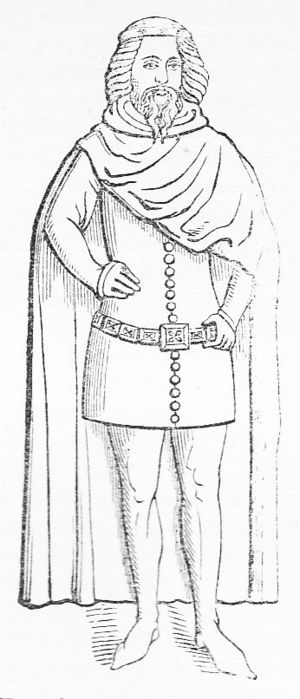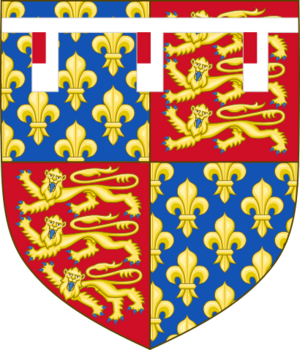Lionel of Antwerp, Duke of Clarence facts for kids
Quick facts for kids Lionel of Antwerp |
|
|---|---|
| Duke of Clarence | |

Lionel, Duke of Clarence. 19th-century drawing of bronze statuette on south side of tomb of his father King Edward III in Westminster Abbey
|
|
| Earl of Ulster (jure uxoris) | |
| Predecessor | William Donn de Burgh |
| Successor | Philippa with Roger Mortimer |
| co-Ruler | Elizabeth de Burgh |
| Born | 29 November 1338 Antwerp, Duchy of Brabant (now Belgium) |
| Died | 17 October 1368 (aged 29) Alba, Piedmont |
| Burial | Clare Priory, Suffolk |
| Spouse |
|
| Issue | Philippa, 5th Countess of Ulster |
| House | Plantagenet |
| Father | Edward III, King of England |
| Mother | Philippa of Hainault |
Lionel of Antwerp, Duke of Clarence, was an English prince. He was born on 29 November 1338. Lionel was the third son of King Edward III and Philippa of Hainault. He was named after his birthplace, Antwerp, which is now in Belgium. Lionel grew to be very tall, almost 7 feet (213 cm). He also had a strong, athletic build.
Contents
First Marriage and Irish Lands
When Lionel was a child, he was promised to Elizabeth de Burgh, 4th Countess of Ulster. She was the daughter and heir of a powerful Irish lord. They married in 1352. Even before their marriage, Lionel gained control of Elizabeth's large land holdings in Ireland. From 1347, he was known as the Earl of Ulster.
Lionel's Time in Ireland
Lionel was chosen to represent his father, King Edward III, in England in 1345 and 1346. In 1355, he joined a military trip to France. However, his main focus was on the affairs of Ireland.
In 1361, Lionel was made the governor of Ireland. He arrived in Dublin to take up this role. In November 1362, his father made him the Duke of Clarence. This was only the third time someone had been given the title of duke in England. King Edward III also tried to make Lionel the king of Scotland, but this plan did not work out.
Lionel tried to gain full control over his lands in Ireland. He had some success, but it was difficult. In 1366, he held a special meeting called a parliament in Kilkenny. At this meeting, they passed important laws known as the Statutes of Kilkenny. These laws aimed to keep English settlers in Ireland separate from the native Irish. After this, Lionel became frustrated and returned to England.
Did you know that the famous poet Geoffrey Chaucer worked as a page (a young servant) in Lionel's household for a time?
Second Marriage and Later Life
Lionel's first wife, Elizabeth, passed away in 1363. Later, a second marriage was arranged for him. He married Violante Visconti, whose father, Galeazzo Visconti, was a powerful lord in Italy. Her brother was the Duke of Milan.
Lionel traveled to Italy to meet his new bride. He was welcomed with great celebrations in both France and Italy. He married Violante in Milan in June 1368. They spent several months celebrating. During this time, Lionel became ill in Alba, Italy. He died there on 17 October 1368, at the age of 29.
Lionel's Family and Legacy
Lionel had only one child, a daughter named Philippa, 5th Countess of Ulster. She was the child of his first wife, Elizabeth. In 1368, Philippa married Edmund Mortimer, 3rd Earl of March.
Lionel's family line became very important in English history. Philippa's granddaughter, Anne Mortimer, married into the Yorkist branch of the royal family. Anne was the mother of Richard Plantagenet, 3rd Duke of York.
The Yorkist family later claimed the English throne. They said their claim was stronger because it came through Lionel's daughter, Philippa. This made their claim older than the Lancastrian family's claim, which came from Lionel's younger brother, John of Gaunt.
Because of this, Lionel is an ancestor of many English and British kings and queens. These include Edward IV, Edward V, and Richard III. All later British monarchs are also descended from Lionel, except for Henry VII, whose wife Elizabeth of York was Lionel's descendant.
Arms
Lionel's coat of arms showed his royal connection. One version of his arms used the symbols of the kingdom. It had a special white stripe with five points. Each point had a red cross, like the flag of Saint George. Another idea is that he used a white stripe with three points, each having a red square.
See also
 In Spanish: Leonel de Amberes para niños
In Spanish: Leonel de Amberes para niños


